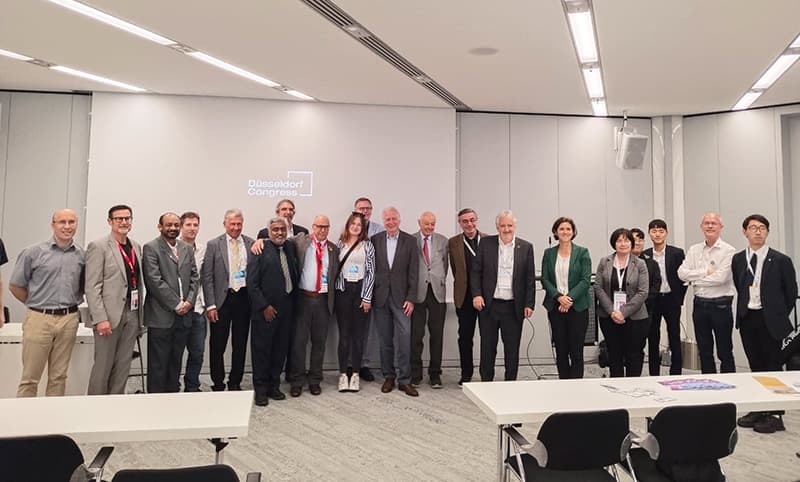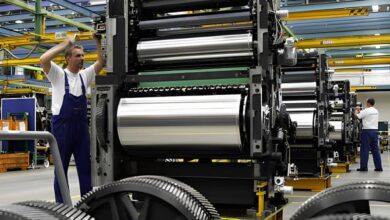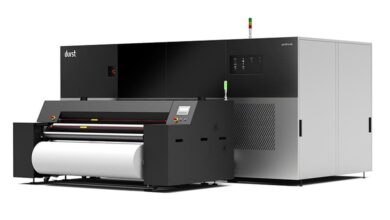Future of the Printing Industry in the Light of drupa 2024
What to Look for and What to Adopt?

By: Prof. Rajendrakumar Anayath
At the BRIDGING Industry with Research and Education event during drupa 2024, on 30th of May at CCD South, Messe Dusseldorf, Prof. Rajendrakumar Anayath, the internationally acclaimed Printing Teacher & Researcher, delivered the keynote address that highlighted the transformative journey of the printing industry. He emphasized the critical shift towards ‘Print 4.0,’ driven by globalization and digitization, and the necessity for print service providers to invest in future-proof technologies. Dr. Anayath discussed how current trends—focused on quality, cost, and time—are being addressed through digitalization and automation, leading to greater transparency and optimized logistics. He explored global trends projected by DRUPA research, such as technological advancements, Industry 4.0, sustainability, and the integration of AI, cloud computing, and web-to-print software. His vision for the future includes adopting Open Platform Communications (OPC) and Managed Print Services (MPS) to achieve flexibility, scalability, and efficiency, urging print organizations to embrace innovations showcased at drupa 2024 for a vibrant and sustainable future.
Here is his full keynote address:
Traditional printing industry has already transformed in to its new Avtar by adopting ‘print 4.0’ just like many other manufacturing and service industries.
Continued globalisation and digitisation have a great impact on the printing industry. Customers today are able to compare offers with just a few clicks and place orders using convenient online processes nationwide or even internationally. Online print service providers are setting the pace in the market. Customers value high standards as well as a consistent brand image down to the finest detail. State-of-the-art technology is key to meeting these customer demands. To continue to thrive in the long run, print service providers will have to face up to the challenges of globalisation and digitisation. This requires consistent investment in future-proof technologies.

Current market trends in print industry are Quality, Cost and Time, which are addressed through digitalisation and automation. This transition would help us to get better transparency in decisions, optimisation of logistics and also some excellent benchmarks. Standardisation has become much more relevant and prominent in this context. Global trends in print industry projected by DRUPA research reports are, basically on Technological changes, Specialization, Industry 4.0, Demographical Changes, Automation, Sustainability, Security & Brand Protection, and Data Driven Applications. The same report predicts specific print Industry growth potentials in Functional Printing, Industrial Printing, Finishing & Decoration, Package Printing, Active & Intelligent Packaging, Inkjet Applications and Textile Printing. They also identified four mega trends which will have great impact on the printing industry as below:
- Artificial Intelligence
- Connected Customers
- Platform Economy and
- Circular Economy. Indeed, sustainability and environment are also considered as important topics.
Today, I want to bring your attention in to a couple of concepts in connection with the above findings. Thus, in this paper you may not see any comparative study on traditional printing processes like Offset, Flexo, Screen or Gravure. Actually, all these are another major topic and we may have to discuss it in detail in a separate session. My observations in this paper are primarily based on “Print 4.0 ”.
First of all, I am seeing an interesting transition in data communication. I believe the future leader of the world would be the one who has the most accurate DATA…DATA…and DATA… and your ability to gather it on time, analyse it and take appropriate inference out of it . Print industry already started using OPC systems. Open Platform Communications ( in acronym “OPC” ) is a series of standards and specifications for industrial telecommunication. OPC specifies the communication of real-time plant data between control devices from different manufacturers in different locations. After the initial release in 1996, the OPC Foundation was created to maintain the standard globally.
OPC Unified Architecture (OPC UA) is a ‘ Machine-to-Machine ’ communication protocol for industrial automation developed by the OPC Foundation. It is based on a client server communication which focuses on communicating with industrial equipment and systems for data collection and control. In todays production systems ( We also need to change our habit of calling print industry from a mere service industry to MANUFACTURING ). With the possibility of
providing mobility in services beyond physical locations through technologies like Cloud Computing, Business Analytics and AI, every print organisation can achieve Flexibility, Scalability, Better OEE, Greater Efficiency with Minimal Wastage, Reduced Operating Expenses and Capital Costs. Managed Print Services (MPS) show a ray of hope for Printing OEM’s. It gives the potential to printers go beyond their traditional role of just managing a printing process to
integrating workflows with IT infrastructure allowing management of digitized information and business processes irrespective of software systems from various companies. However, this potential can be tapped only if MPS can adapt to the next generation trends like Bring Your
Own Device (BYOD) in to any Printing Machine made by any manufacturer and On Demand Solutions can create meaningful dialogues between a heterogeneous Printer Fleet through off premise or hosted software, and it can integrate multiple vertical solutions and workflows. I
anticipate next Generation “Open Multi Vendor MPS Solutions Platforms” (OMVMPSSP) can make this magic happen in our industry. Based on open-layered, modular and SKU ( Stock Keeping Units ) based architecture, the Next Generation MPS Platforms can enable Mobile Printing Ecosystems, interface with competitive MFPs ( Multi-Function Peripheral ) and run vertical workflow solutions on any MFP device using cloud & web services that leads to achieve emerging technology needs like cloud enablement.
Open Multi Vendor Solutions Platform:
OMVSP are the need of the hour for print organisations. It is applicable to both machine manufacturers and users. In today’s market, traditional print OEM’s are also offering MPS solutions by replacing existing company specific devices with their own devices to manage print in a better way. But, new print organisations with the consumerization of IT and increasing prevalence of BYOD and virtualization of IT resources/assets has resulted in demanding better quality, cost and time by all stake holders. The demand of the new age organisations include better decisions, enhanced document management, workflow, archiving, business process and control over any unstructured or structured data entering the organization. How does a traditional OEM satisfy all these demands is a big question we need to answer ? At present an Open Multi-Vendor MPS Platform can achieve the same. The solution would include a stakeholder specific UI and database mapping, separate business logic in applications, pre-built stake holder specific extensibility adapters, pre-built common functionalities, and a browserbased UI.Now after the tough covid time global business as a whole is stabilized and it is double happy to note that print industry is in a brilliant growth path. Of course, I am not denying that a world war is mongering Infront of the world, still let us hope that everything shall get settled by year end. Printing industry is no more the same ink and paper. Printers are adopting new materials, applications, modern methods and opportunities to expand their business reach. To comprehend the printing business in 2024, I want to discuss a couple of trends & ideas on how printing industry is transforming business around the world.
Privacy & Security:
Businesses including all kinds of production, services, education and health services, are putting resources into technology that needs privacy and security to gather various information. This is because any stakeholder “Privacy-Security” is one of the major aspects in bringing a brand value to any organization. Companies have to look for ways to improve effectiveness with remote work through advanced technology amalgamation in the printing business. Only this would guarantee Security, Speed, Cost, Quality.
Digitalisation Through Technological Adoption:
According to a study report around 93% of printing business people accepted that modern technological developments based on print 4.0 are already visible in their business in some form. Modern printing tools are receiving the new report feature included that allows stakeholders to digitize their documents and store information easily in a verifiable manner. Digital work process forms that can interact with intended customers to the frameworks and also enable intended user to work remotely and keep following up printing through any gadget they desire since every gadget is going to be intelligent and inter communicable. Thus, we have to embrace new technological developments to stay competitive in the market. By choosing appropriate IoT based data analytics, web to print software, AI and cloud applications, the printing business would experience further perfection in manufacturing, both in large and small production companies. You can expect a multifunction printing machine that would provide facility and systems across-the-board to every intended individual or firm. Happy to note that all our traditional print technology leaders are developing, adopting such tools and software.
The Design Change:
We no longer need customary prints loaded with elements. Modern individuals are inclining toward a basic picture with a rich look and feel over a profoundly entangled graphical image. Similarly, utilize the most extreme void area and pick a design that is straight forward, clean, and fill the need. In any case, the customers would need something that can be distinct, beautiful and popular in their designs that helps to add value to their brand.
Artificial Intelligence (AI) :
Print business leaders have already started utilizing AI technology in their business model. I am talking about every segment in our industry viz; manufacturers, users, vendors and customers. As 2023 encountered some astounding success in improving capacities for printers and MFPs and we can expect to see some commendable upgrades soon. Companies like Xerox and HP have already extended their abilities in this segment. Traditional machine manufacturers like KBA, Heidelberg, Komori and other leading flexo, gravure leaders are all stepped up in to this requirement of the time.
Inkjet :
Ink-Jet has matured a lot now. I do not know what is not possible with Inkjet now? It goes far beyond the materials, substrates and contours. No restriction on ink and the kind of materials to be transferred. Inkjet is a master in both cut-sheet and web fed. Inkjet makes any work cost effective, fast and consistent in quality.
Association of IT:
A business survey says, IT specialists’ cooperation would be much more seen among the traditional print providers by 2025. To achieve mastery, printer will have to develop their IT expertise in to their work culture. Companies like Kyocera, Konica have made a move in this direction by expanding IT service capacities through acquisitions. I could also see similar attempts made by traditional printing machine manufacturers in offset and flexo too.
Adoption Of Cloud MPS:
Another move that is occurring in the printing industry is the acceptance of cloud-based MPS. Market leaders, including HP, Ricoh, Xerox, and Lexmark have adopted this technology. This incorporation of cloud MPS will diminish the intricacies of on-premise printing. A virtual print server shall handle everything and hence, it would dispose of all the requirements of on-premise servers.
Embracing best logistics and customising prints :
In the modern print world, irrespective of the process, we have an opportunity to personalise anything and everything that we do. So, we can create an opportunity for all our stakeholders. Custom packaging, Publication printing, Item architect devices, Customized flyers etc. shall certainly give our print marketing a competitive advantage through a brand image. This opportunity can allow us to utilize appropriate product design software, which can coordinate with our online store. These developments started in 2019 and matured well in 2023. I am sure all these developments are going to empower the printing businesses.
Thus If you want to be in market, it is very crucial to integrate AI, Cloud, Web to Print to your existing operations and web-store. These technologies are going to empower the printing ecosystems in the coming time. If you are looking for solutions to stay relevant to the changing business trends, it is very crucial to integrate all these modern scientific trends in to your business. Growth is not an option or choice anymore. If you decide that you don’t want to grow, I can tell you… you are embracing slow death. I mean… somebody is going to replace you. So be ready for a change.

We can see all these concepts in action at DRUPA-2024 at Dusseldorf and thus it is the platform to look and learn for what we need and what to adopt.
Wish you all a Smart, Colorful, Embellished, High fidelity printing time ahead!

.gif)



